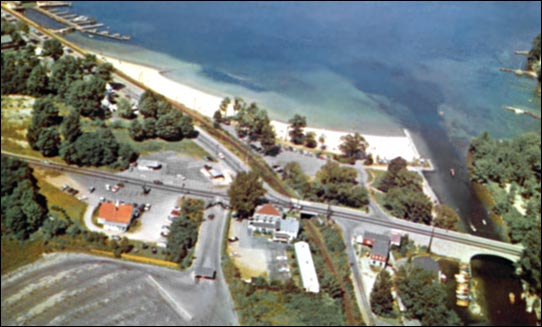 |
| Postcard postmarked 9-6-71: Kummerlowe Archive |
Laconia,
New Hampshire
-- Rts 3 & 11 AKA Weirs Beach |
The
following commentary is provided by Nate Coggeshall-Beyea who
has extensively studied and documented the history and development
of Howard Johnson's in New Hampshire:
Originally opened
as a Dutchland Farms restaurant in roughly 1934, the Laconia store
enjoyed a very colorful history. It was initially located in Laconia,
at the intersection of Route 3 (Daniel Webster Highway) and Route
11. As the largest city in the Lakes Region, Laconia had become
a popular destination for motorists by the 1930s. The natural
beauty of nearby Paugus Bay and Lake Winnipesaukee had long been
Laconia’s greatest attraction, drawing in tourists far and
wide to the city. The Route 3 and Route 11 intersection, locally
known as McIntyre Circle, was another gateway, tying the Lakes
Region to the seacoast, the White Mountains, and points south.
Thousands of motorists would pass through this interchange each
year, on their way to the lakes for the summer and the north country
for skiing in the winter. It is no wonder then that Dutchland
Farms picked this specific location to erect one of its roadside
restaurants nor any surprise that HJ later sought to incorporate
this franchise into its emerging empire. |
The first known listing for HJ at this location was 1938. For approximately ten years, McIntyre Circle was a very viable location for HJ. Meanwhile, about three miles north on Route 3, Weirs Beach was fast becoming a hot spot for summer tourists and vacationers. Traffic flow was increasing dramatically through this area, drawing in restaurants, gas stations, and shops. By the late 1940s, traffic flow at Weirs Beach was far supplanting traffic flow at McIntyre Circle. As a result, HJ moved the Laconia store to Weirs Beach in the late 1940s, constructing a new neocolonial style building to house the relocated restaurant. The new structure was similar in shape and form to Hooksett, a single dining room structure, with a Portsmouth style cupola, three large dormers with rectangular windows, and a square-closed entrance way. It is believed that at least the cylinder and cone portion of the cupola were moved from the Laconia location. The Orleans type sign that was erected at the new site surely was moved from the old location. The Weirs Beach store was situated on Route 3, directly across from Lakeside Avenue, the main entrance to Weirs Beach. A large flashing neon sign reading “Weirs Beach” was positioned at this intersection, capturing the attention of motorists traveling along Route 3. Likewise, the entrance to the Weirs Beach Drive-In movie theater ran alongside the HJ property, drawing in motorists. Thus, in locating its store adjacent to this intersection, neon sign, and movie theater, HJ had claimed the best possible real estate in the area, assuring that everyone passing through would see its restaurant. For this very reason, HJ dominated the landscape here for many years. |
|
In the early 1980s, the Weirs Beach store was sold by its original owners, who had owned the franchise since its opening in 1934. Shortly thereafter, the new owner dropped the HJ franchise and renamed the complex the Weirs Beach Family Restaurant and Gandy Dancer Saloon. The top part of the cupola was removed, as was standard practice for Nims Two style cupolas when restaurants were re-branded, and the trapezoid sign was encased in a new wooden sign for the new restaurant. A sign featuring the words “HAV-A-BITE” was also added above the front entrance. Much like Hooksett, this location’s reincarnation was only short-lived. The entire complex burned to the ground on October 7th, 1984, and although the new owner had planned to rebuild, this never occurred. Today, the location remains a vacant lot, used on occasion for bus parking and outdoor vendor space. The covered-over trapezoid sign is the only HJ relic that has survived the course of time, now serving as a signpost for the nearby Weirs Beach Lobster Pound. |
The
purpose of this site is informational. It is neither commercial
nor representative of any brand, company, or business. Trade names,
trademarks, etc. that are depicted remain the property of their
respective owners. Please contact this site's owner
prior to reproducing any part of it. Works from contributors (includes
photographs, ephemera, etc.) must not be reproduced without their
explicit consent. |